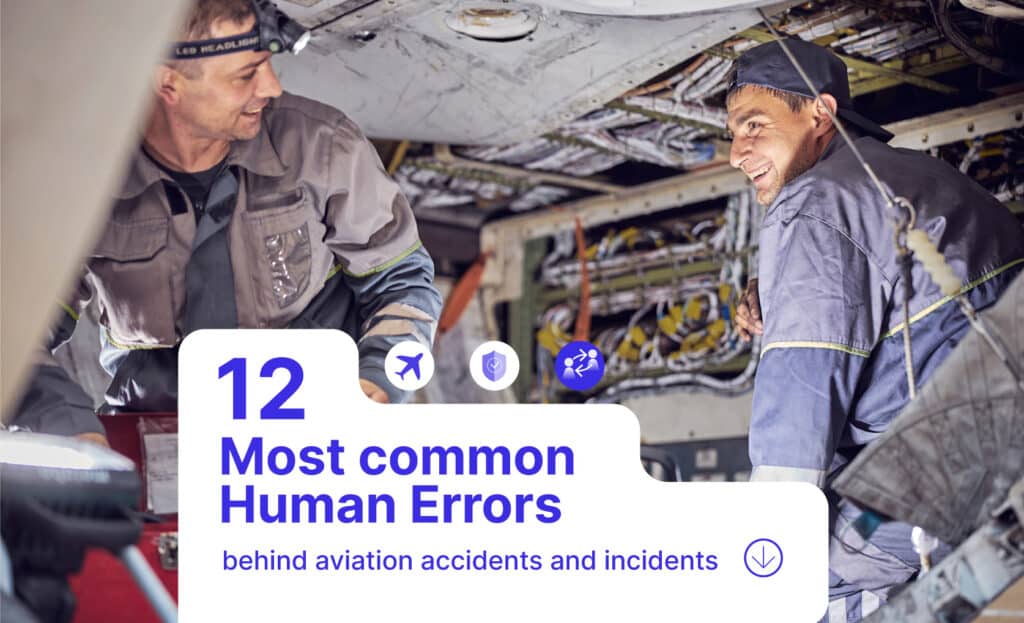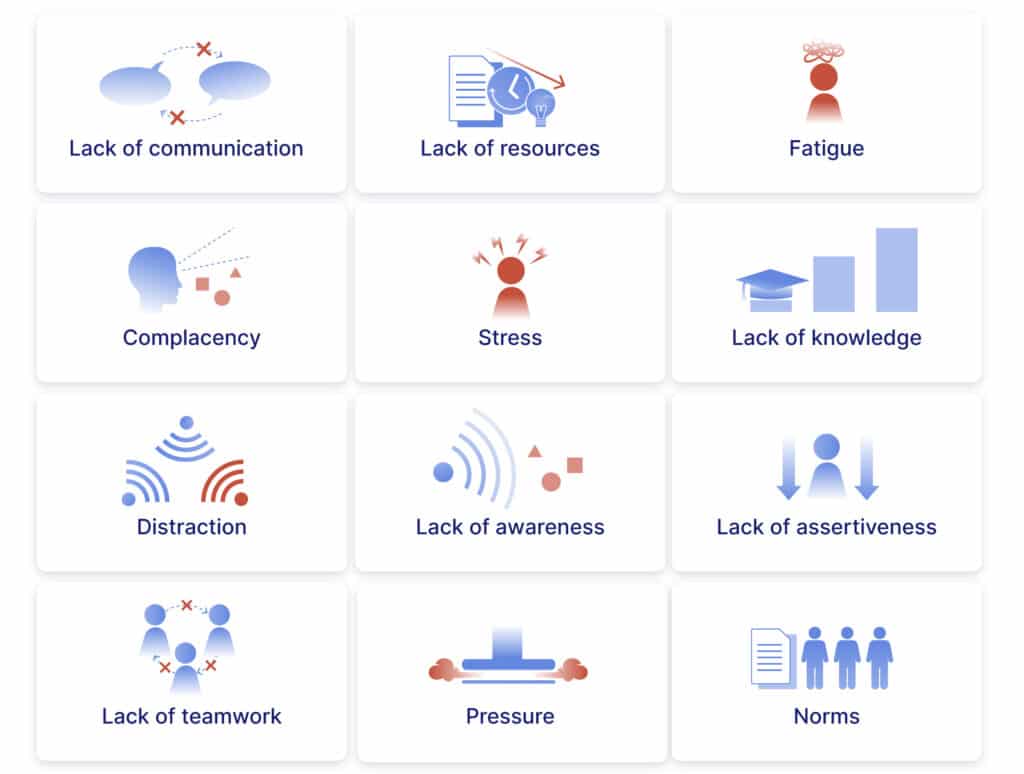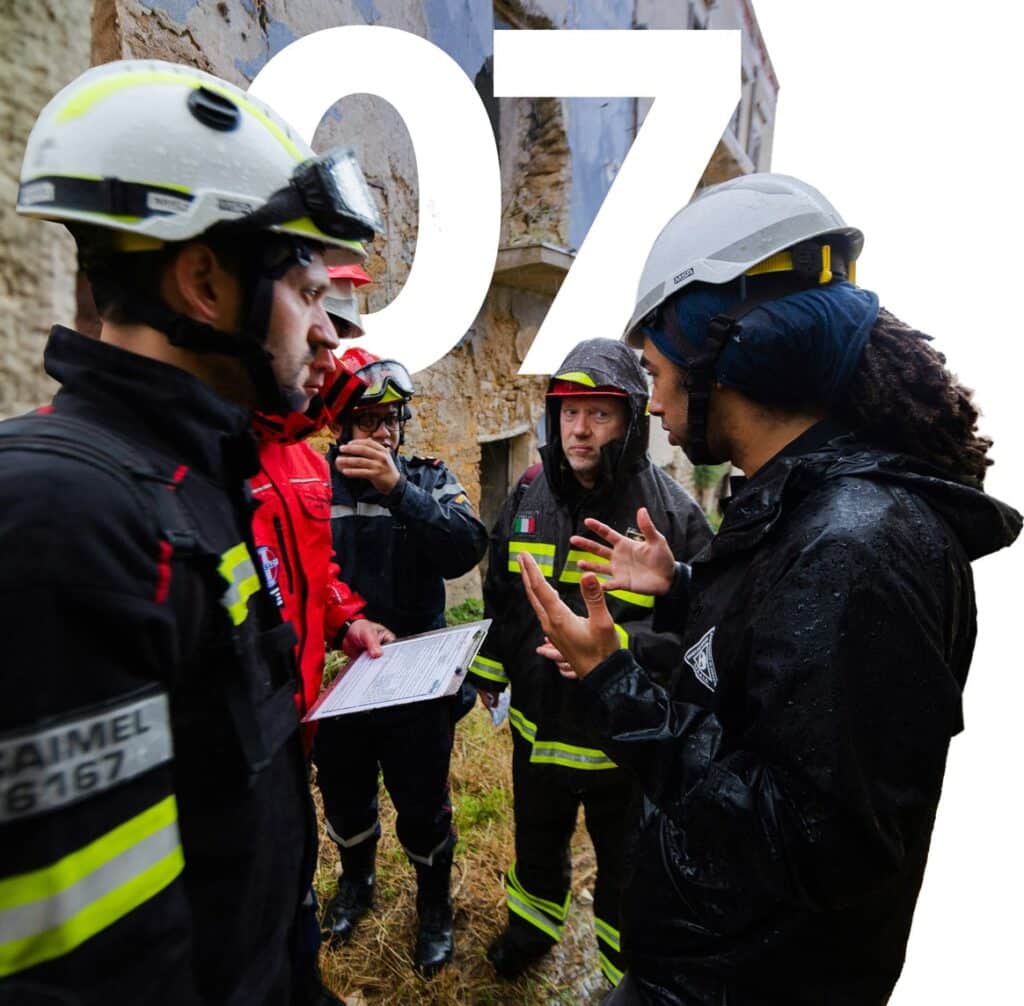
In this article, we’ll explore each of the twelve Dirty Dozen factors and their countermeasures.
Discover all our aviation-related topics.
Maintenance-related issues caused a significant number of aviation accidents and incidents during the late 1980s and early 1990s. This led Gordon DuPont who was working for Transport of Canada in 1993, to identify twelve factors that can have a negative impact on a person’s ability to perform tasks safely and effectively. These factors are collectively known as the “Dirty Dozen”. Although initially intended for aircraft maintenance, the human factor field now uses the Dirty Dozen as an introductory concept.
There is no particular order of priority in the twelve human errors part of the Dirty Dozen:

To counter these factors, specific measures are designed for each element of The Dirty Dozen.
The twelve human error precursors in the Dirty Dozen list is not an all-inclusive list of potential human error accident precursors. For instance, ICAO has recognised more than 300 human error precursors. Nonetheless, since 1993, all sectors of the aviation industry, not just aircraft maintenance, have found the Dirty Dozen to be a valuable starting point for discussing human error in their businesses, organisations, and workplaces and a fundamental part of Human Factors training in aviation maintenance courses all over the world.
Poor communication is often cited as one of the leading causes of accidents. Communication involves the sender, the receiver, and the method of transmission. Sometimes, the instructions sent may be unclear or inaccessible, and the receiver may assume the meaning of the instructions. Studies suggest we only receive and understand 30% of a message in verbal communication.
What countermeasures can we take?
Distraction can refer to anything that takes a person’s attention away from the task they are working on. Some distractions in the workplace are unavoidable, such as loud noises, requests for help, and safety issues that require immediate attention. Other distractions, like personal messages, administrative work, or social conversations, can be avoided or postponed.
During maintenance procedures on an aircraft, distractions can disrupt the process, leading to missed details.
What countermeasures can we take?

Various resources, such as personnel, time, data, tools, skills, experience, etc., are necessary to complete any task. A lack of resources, such as insufficient staffing, equipment, documentation, time, parts, etc., can interfere with one’s ability to complete a task. It may also be the case that the available resources, including support, are of low quality or inadequate for the job.
A technician may feel pressured to complete a task using old or unsuitable parts. When the proper resources are available, there is a greater chance of completing a task effectively, correctly, and efficiently.
What countermeasures can we take?
There are two types of stress: acute and chronic. Acute stress happens when we experience real-time demands on our senses, mental processing and physical body, such as dealing with an emergency or working under time pressure with inadequate resources. Chronic stress accumulates over time and results from long-term demands placed on the physiology of life’s demands, such as family relations, finances, illness, grief, divorce, or even winning the lottery. Long-term stress lowers our reaction threshold to demands and pressure at work, leading us to overreact too often and too quickly.
Some early signs of stress include changes in personality and moods, errors of judgement, lack of concentration and poor memory. Individuals may notice difficulty sleeping, an increase in fatigue, as well as digestive problems.
In aviation maintenance, stress is always present due to various factors. Aircraft must be airworthy and flying to make money for any airline, which means maintenance must be done within a timeline to avoid flight delays or cancellations. Stress is a subconscious response to these demands.
What countermeasures can we take?

Complacency refers to a state of self-satisfaction and loss of potential danger awareness.
Too much pressure results in over-stress and reduced human performance, while too little pressure leads to under-stress, boredom, and complacency, which also reduces performance.
Individuals often exhibit complacency during routine activities that have become habitual and are considered easy and safe.
This state of mind results in a general relaxation of vigilance, leading to missing signals and seeing what one expects to see.
As maintenance personnel gain experience in repeated tasks, they develop feelings of self-satisfaction and false confidence, leading to the neglect or skipping of some tasks, such as inspections. The misconception is that inspection of the item is not essential. Working from memory, assuming something is okay when unchecked, and signing off incomplete work should be avoided. Teamwork and mutual cross-checking can provide enough stimulus when fatigued.
What countermeasures can we take?
In aviation, many tasks and operations are team efforts, and no single person or organisation can be solely responsible for ensuring safe outcomes. Thus, if someone isn’t contributing to the team effort, it can lead to unsafe results. Workers must rely on their colleagues and other outside agencies and provide support to each other.
Aircraft maintenance involves several specialised personnel with different roles. However, they all share a common goal: keeping the aircraft airworthy. Therefore, each operator is an essential part of a complex organism that must work together, making teamwork essential.
It’s crucial to ensure that everyone in the team understands and agrees, establishing a working relationship based on mutual trust. Leave personal differences outside the workplace, and organisations should emphasise that a lack of teamwork can ultimately affect aviation safety.
What countermeasures can we take?

Aviation maintenance is a field that demands people to work in an environment that involves continuous pressure to perform better and faster without making any errors. Pressure is a natural aspect of working in a dynamic environment, but it can become overwhelming when it affects our ability to complete tasks correctly.
This pressure can arise due to a lack of resources, especially time, making it challenging to cope with the workload. We can also experience direct or indirect pressure from our company, clients, and colleagues.
However, we often put pressure on ourselves by taking on more work than we can handle, especially when we try to solve other people’s problems and promote ourselves as superheroes. Assumptions about what is expected of us often lead to poor decisions.
What countermeasures can we take?
It is essential to be aware of our situation and understand its possible outcomes. If we fail to identify all the consequences of our actions, it can lead to tunnel vision and an incomplete understanding of the effects of our actions on others.
Vigilance is closely related to situational awareness, and we can maintain our attention by following workplace procedures such as scanning, two-way communication, and checklists.
What countermeasures can we take?
Workers must have the necessary knowledge about the topics they are working on. A lack of knowledge can result in misinterpreting situations and making unsafe decisions. The shortage of training, information, and ability to perform successfully can lead to disastrous consequences, particularly when performing aircraft maintenance. Faulty repairs due to a lack of knowledge can have catastrophic effects.
Aircraft systems are intricate and integrated, and performing tasks without substantial technical training, current relevant experience, and adequate reference documents are nearly impossible. It is also crucial to note that systems and procedures can change substantially, and employees’ knowledge can quickly become outdated.
What countermeasures can we take?
Fatigue is a natural response to prolonged physical and mental stress. It can result from long hours of work or intense work. Fatigue can be either physical or psychological, and it can also cause emotional fatigue that affects mental and physical performance. Stress and overworking can lead to fatigue, making us easily distracted, emotionally unstable, and prone to making poor decisions.
One of the significant issues with fatigue is that we tend to underestimate its impact on us and overestimate our ability to cope with it. Therefore, as workers, we must be aware of the signs and symptoms of fatigue in ourselves and others.
What countermeasures can we take?

Lack of assertiveness can occur when someone lacks the self-confidence to speak up for their rights and ideas, ultimately leading to the failure to communicate concerns about instructions, orders, or the actions of others. This lack of assertiveness can result in fatal accidents when individuals fail to alert others when something seems wrong.
Assertiveness is a communication and behavioural style that allows us to express our feelings, opinions, concerns, beliefs and needs positively and productively.
It is about communicating directly, honestly, and appropriately, giving respect to the opinions and needs of others but not compromising our standards.
Unassertive team members can be forced to go along with a majority decision, even when they believe it is wrong and dangerous. A colleague who does not allow others to express their concerns about the selected measure is dangerous, as they may direct the choice without everyone being consulted, increasing the possibility of error.
What countermeasures can we take?
Over time and through experience, individuals shape workplace practices, often influenced by a specific workplace culture. These practices are commonly referred to as “the way we do things around here” and become norms.Unfortunately, these norms may deviate from rules, procedures, and instructions, often enforced through peer pressure and force of habit.
It is crucial to analyse the cultural context of a workplace as it can facilitate bad habits and unsafe procedures. Even newly hired workers may repeat patterns ingrained in the company culture over time. These unwritten rules should not be encouraged and should be avoided by strictly following official regulations to ensure the highest level of safety.
Harmful norms can detract from established safety standards and may lead to accidents.
What countermeasures can we take?
The aviation industry recognises the importance of human factors in maintenance, as they can significantly impact aircraft repair and maintenance activities. The “Dirty Dozen” concept aims to capture and reduce human error in aviation maintenance.
In our human factors training sessions for maintenance personnel, we discuss the “Dirty Dozen” and encourage active engagement with delegates to help them learn how to manage maintenance errors while considering human performance limitations and their potential impact on daily operations.
View all our upcoming Maintenance Human Factors Trainer courses.
Contact us to find out more at +45 26 37 39 39 or ask@naviminds.com.
Dive into our insightful and informative articles that will help you explore more and get ahead of the competition.
© 2024 NaviMinds – Designed by Aveo web&marketing